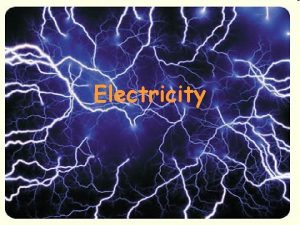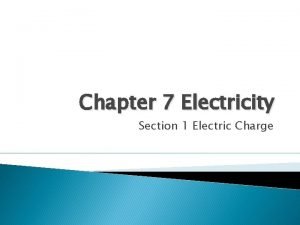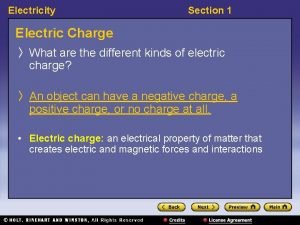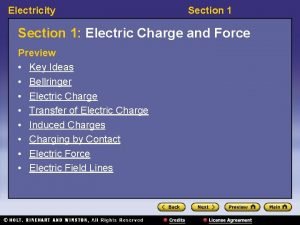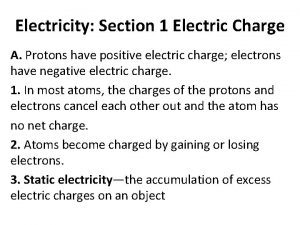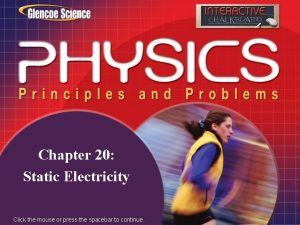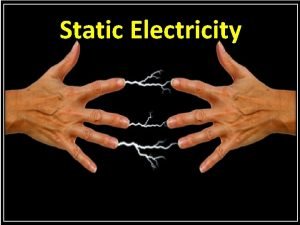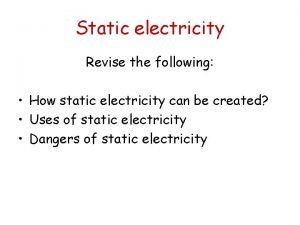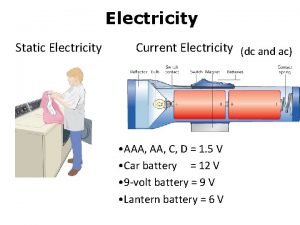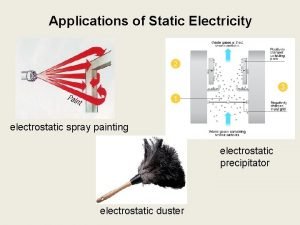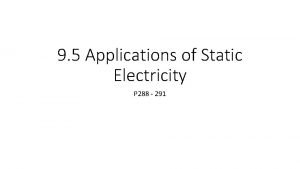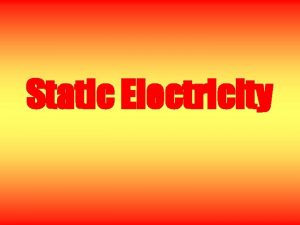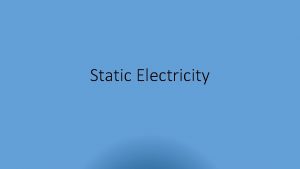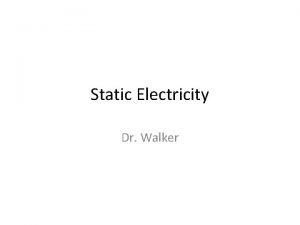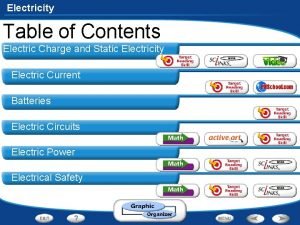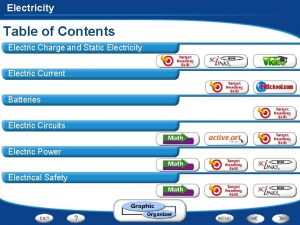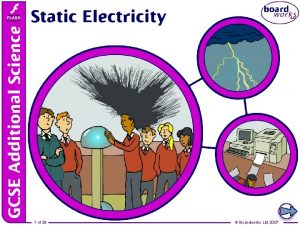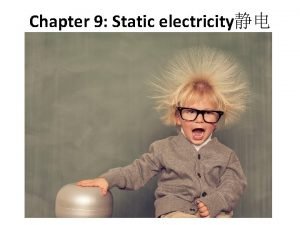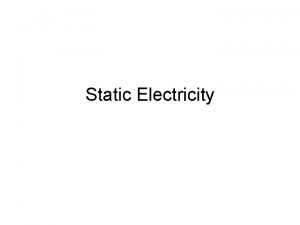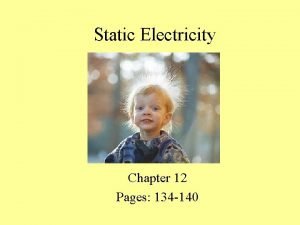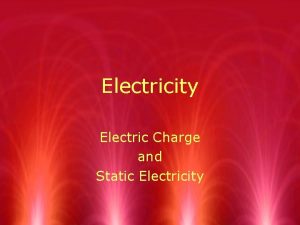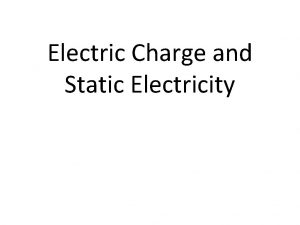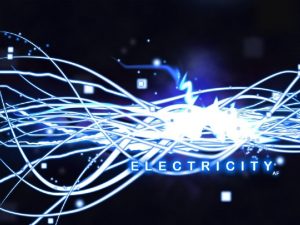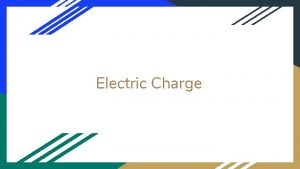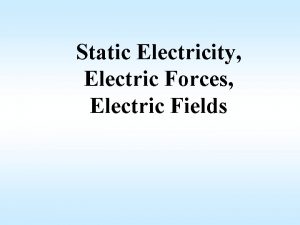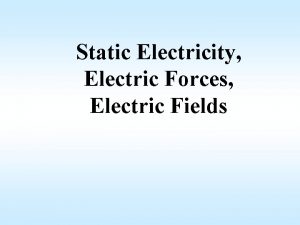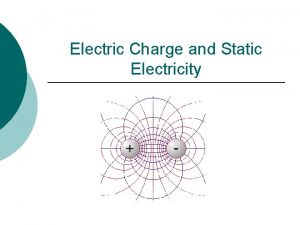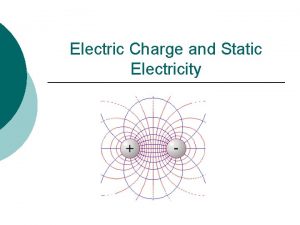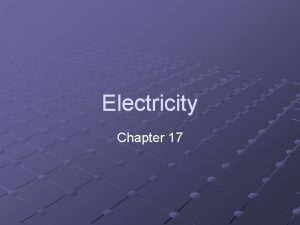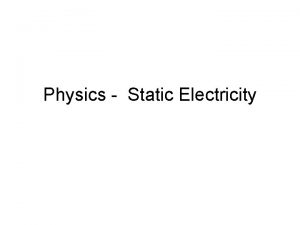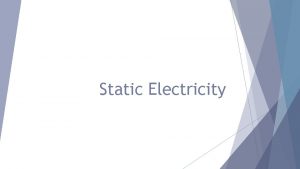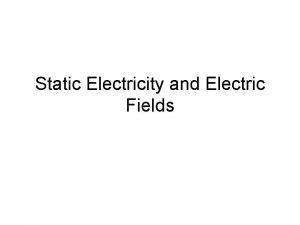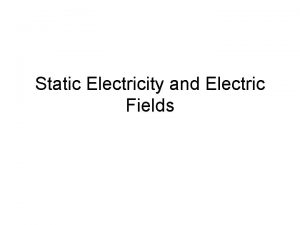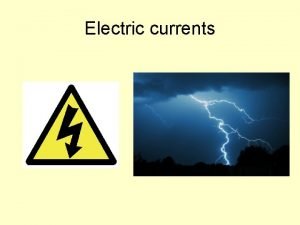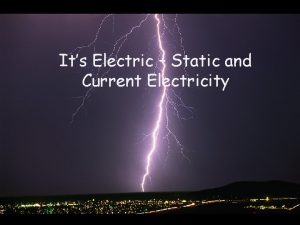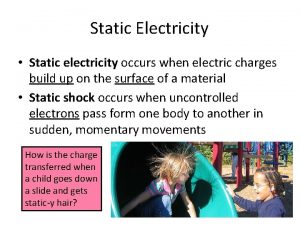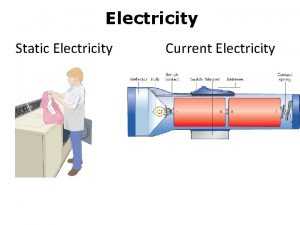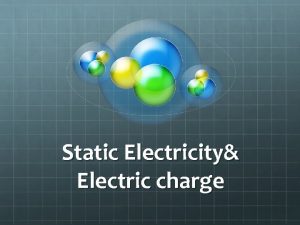Chapter 7 Electricity Section 1 Electric Charge Static

































- Slides: 33

Chapter 7 Electricity Section 1 Electric Charge

Static Electricity � Accumulation of excess electric charge � As you walk across the carpet, electrons are transferred from the carpet to your shoes � Your shoes become negatively charged � The carpet becomes positively charged

Law of Conservation of Charge � Charge can be transferred from object to object, but it cannot be created or destroyed. � Usually place the electrons move from place to

Forces and Electric Charge � “Like” charges repel � “Unlike” � This charges attract is why clothes from the dryer stick together due to the transfer of electrons

Electric Fields � There is an electric field around every electric charge � Example: Being shocked when you reach for a doorknob but do not actually touch it

Conductors and Insulators � Conductors- electrons move through easily Ex: Metals � Insulator- electrons do not move through this material easily Ex: Plastics

Charging Objects � Charging by contact- charge is transferred by touching or rubbing � Charging by induction- charges are rearranged on a neutral object due to a nearby charged object

Explain why if charge cannot be created or destroyed, electrically neutral objects can become electrically charged.

Humid air is a better electrical conductor than dry air. Explain why you’re more likely to receive a shock after walking across a carpet when the air is dry than when the air is humid.

Chapter 7 Electricity Section 2 Electric Current

Electric Current � This is the flow of electrons � Measured � The in amperes; amps rate that the electrons move through a conductor.

Voltage Difference � Related to the force that causes electric charges to flow � Measured in volts; V

Voltage � Electric Charge flows from higher voltage to lower voltage A. K. A. : � Potential Difference- the work that must be done to move a charge from one place to another

Circuit � Closed path that current flows through � Current will only flow on a closed path

Resistance � How much a material opposes the flow of electrons � Measured in ohms; Ω

Resistance � Temperature � Length � Thickness *When these increase so does resistance

Ohm’s Law � Equation Current = voltage difference resistance or I= V R

Example Calculate the voltage difference in a circuit with a resistance of 25Ω if the current in the circuit is 0. 5 A.

Example A current of 0. 5 A flows in a 60 W light bulb when the voltage difference between the ends of the filament is 120 V. What is the resistance of the filament?

Chapter 7 Electricity Section 3 Electrical Energy

Closed vs. Open Circuit � Closed � Open Circuit: Charge can flow uninterrupted Circuit: Charge cannot flow; circuit is broken

When one bulb is out in a string of lights, why do the rest not work? ?

Circuits � Switch- used to open and close a circuit - Ex: Light switch in your home � Schematic Diagram- a diagram that depicts the construction of an electrical circuit or apparatus

Series Circuit � The current can only flow through one loop � Used in flashlights and holiday lights

Parallel Circuits � These have two or more circuits the current can move through � Used in houses and automobiles � Useful because unlike series circuits, individual parts can be turned off without affecting the entire circuit

Household Circuits � If too much current flows through the wires, they will overheat and melt which can cause a fire � To protect against this fuses and circuit breakers are used

Fuses � These contain a small piece of metal that will melt if it becomes too hot � This causes a break in the circuit which stops the flow of current � You must replace these with new ones

Circuit Breaker � Contains a piece of metal that bends when it overheats � The bending causes a switch to flip which opens the circuit and stops the current flow � These may be reset by flipping the switch

Electric Power � How fast electrical energy is converted to another type of energy � This etc. can be thermal, light, mechanical energy

Electrical Power Equation Electric power = current X voltage difference P= I(V) *Measured in watts; W *One kilowatt (k. W) = 1, 000 watts

Example The current in an electric clothes dryer is 15 A when it is plugged into a 240 volt outlet. How much power does the clothes dryer use?

Electrical Energy � Measured � Equation: in kilowatt hours (k. Wh) Electrical energy = electric power X time or E= Pt

Example A microwave oven with a power rating of 1, 200 W is used for 0. 25 h. How much electrical energy is used by the microwave?
 Chapter 6 electricity section 1 electric charge answers
Chapter 6 electricity section 1 electric charge answers Section 1 electric charge crossword puzzle answers
Section 1 electric charge crossword puzzle answers Electricity section 1 electric charge
Electricity section 1 electric charge Static electricity and current electricity
Static electricity and current electricity Current electricity
Current electricity Magnetism vocabulary
Magnetism vocabulary Chapter 21 electric charge and electric field
Chapter 21 electric charge and electric field Chapter 21 electric charge and electric field
Chapter 21 electric charge and electric field Coulombs units
Coulombs units Units of a charge
Units of a charge Chapter 17 section 1 electric charge and force answer key
Chapter 17 section 1 electric charge and force answer key Difference between charge and electric charge
Difference between charge and electric charge Difference between charge and electric charge
Difference between charge and electric charge Section 1 electric charge crossword puzzle answers
Section 1 electric charge crossword puzzle answers Section 1 electric charge
Section 1 electric charge Section 1 electric charge
Section 1 electric charge Static electricity chapter 20 answers
Static electricity chapter 20 answers What is static electricity
What is static electricity Photocopier static electricity
Photocopier static electricity Bill nye friction worksheet
Bill nye friction worksheet History of electricity
History of electricity Is static electricity ac or dc
Is static electricity ac or dc How does spray paint use static electricity
How does spray paint use static electricity Static electricity painting
Static electricity painting Stationary electric charge
Stationary electric charge Static electricity examples
Static electricity examples Static electricity
Static electricity Static electricity
Static electricity Electric current graphic organizer
Electric current graphic organizer 2007
2007 Static electricity
Static electricity Static electricity
Static electricity Static electricity
Static electricity Electricity
Electricity

